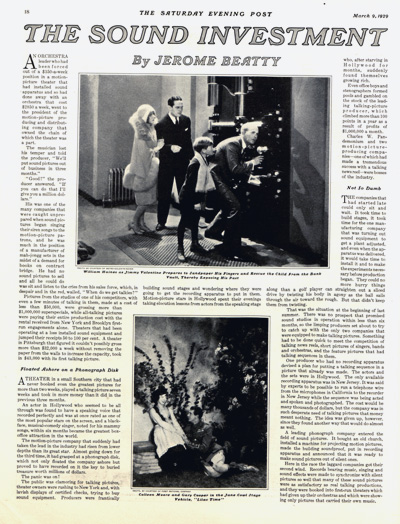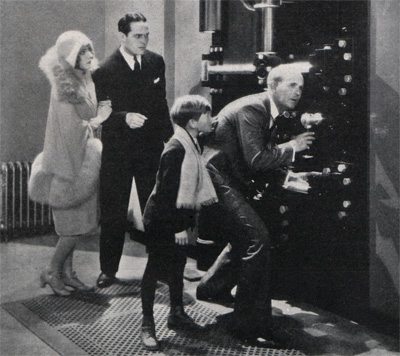On October 6, 1927, Warner Brothers’ studio premiered The Jazz Singer at its New York theater.
The critics who attended the premiere saw a thin melodrama, unremarkable musical numbers, a few minutes of spoken dialogue, and dismissed it as a forgettable novelty.
However, the audience saw a different movie. They saw the future of motion pictures. The New York audience was electrified. They responded with delight to the dialogue, which occupied only a fourth of the movie and was improvised during filming. Some remember that people actually cheered when Jolson delivered his first line of dialogue, “Wait a minute, wait a minute, you ain’t heard nothin’ yet.”
He was inserting a plug for a song he had written, entitled “You ain’t heard nothing yet.” It wasn’t used in the movie, but Jolson thought using the title in a throw-away line was good advertising.
The words, themselves, were unimportant. What mattered was that the audience was hearing someone talk—a breakthrough in movies.
Sound was nothing remarkable. Ever since theater owners began exhibiting movies, sound accompanied the feature, usually from a piano, organ, or, in big cities, perhaps a symphony orchestra. Some theaters had even begun using sound-effects teams. When incorporated into a World War I movie, Post writer Jerome Beatty reported, “the newspaper critics sniffed at the sound effects. Some were out of register, they said, and the whole thing was artificial and ineffective. But the crowds fought to get in and the people who saw the show told their friends to see it.”

The popularity of The Jazz Singer surpassed any of these cosmetic additions of sound because it captured sound and image on the same film. The audio couldn’t stray from the video, as it might on a short phonograph record. The Vitaphone process used in The Jazz Singer enabled spoken dialogue and opened a new dimension in movie-making.
Many movie studios saw the wave of the future and dove in. “Pictures … with even a few minutes of talking in them, made at a cost of less than $50,000, were grossing more than [movies that cost] $1,000,000 … all-talking pictures were paying their entire production cost with the rental received from New York and Brooklyn first-run engagements alone. Theaters that had been operating at a loss installed sound equipment and jumped their receipts 50 to 100 percent.”
One year after The Jazz Singer premiered, over 1,000 theaters were using its Vitaphone system. “By the end of [1929],” Beatty reported, “if present plans are carried out, there will be 3,500 wired theaters in the United States and Canada, and at least 600 abroad.”
Movie critics continued to disparage the new “talkies.” It appeared as if the public and critics were purposely heading in different directions. A theater manager in Dallas summed up the situation in a business telegram to his Los Angeles boss. “Criticism terrible. Business tremendous.”
Several studios worried that “talkies” would prove a short-lived fad. They played with the idea, adding varying amounts of sound to their movies. As a result, audiences never knew what to expect when they entered the theater. The industry began using an informal rating system.
“A picture With Sound is a picture that contains no talking, that has merely a synchronized score. A picture With Sound and Effects contains no talking, but has a score and cued noises. A Talking Picture has talking, music and effects, although the percentage of talking may be comparatively small. When you see An All-Talking Picture advertised, you may be sure that all lines are spoken.”
Sound added a new dimension to motion pictures. According to some historians, dialogue revived the industry just as the public was growing tired of the limitations of silent stories.
It took time, though, for movie companies to make natural sound. It took even longer for them to offer dialogue that was both believable and memorable.
Fortunately, though, early audiences weren’t expecting great dialogue. They also proved that hearing was less acute than vision, and sound effects didn’t have to be realistic if well-timed.
“Provided the volume is right, they [sound-effects engineers] find that exact imitation of noises is not necessary. The eye registers a revolver shot, for instance, and almost any sort of noise, from a bang to a plop, will make the spectator believe he has heard a shot. In recording music and effects for an airplane picture a company took great care to produce the exact and widely different sounds of a British plane, a German pursuit plane, and a German bomber … In an effort to learn whether it was worthwhile to be accurate, persons were questioned after they had seen the picture. Out of more than 100 who were questioned, only 11 had noticed any difference in the sounds, and 6 of those were aviators. These aviators [also] had high praise for the reproduction of the sounds of machine-gun fire which had been made by means of a whirling cogwheel and a barrel stave, after it was found that actual machine-gun fire was so rapid that it did not give the proper staccato effect.”
With the images and voices of actors presented simultaneously, movies seemed more realistic than ever, leading to some unrealistic expectations:
“On the stage … a play may be laid in a foreign land, but the actors speak to one another in English and nobody complains. But one motion-picture critic has complained of a lack of realism in a scene, which was taken from [such] a play and … never questioned. The unrealistic scene is one in which a French peasant speaks to a German. In the picture, as in the play, both talk in perfect English.”
Speaking a foreign language had not been a problem in silent movies. The inter-title card simply gave the original text and an English “translation.” Eventually, the industry adopted a standard that audiences soon learned: Whenever an actor starts delivering his line with a strong accent, we assume he has begun conversing in a foreign language.
Movie sound continued to improve over the decades. Studios added immense orchestral scores. Multiple microphones picked up every spoken word with a clarity better than life. Engineers added stereo, surround-sound, and digitally enhanced effects. None of these improvements, though, match the impact made 82 years ago by the voice of Al Jolson.
Click here to read “The Sound Investment” by Jerome Beatty, March 9, 1929.
Become a Saturday Evening Post member and enjoy unlimited access. Subscribe now




Comments
I love the Saturday Evening Post magazine and so happy it is available on line as well as in print. Thank you!!!